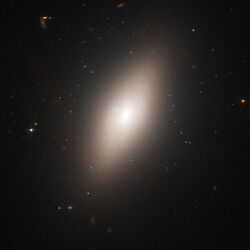Astronomy:NGC 4660
| NGC 4660 | |
|---|---|
 HST image of NGC 4660. | |
| Observation data (J2000 epoch) | |
| Constellation | Virgo |
| Right ascension | 12h 44m 32.0s[1] |
| Declination | 11° 11′ 26″[1] |
| Redshift | 0.003612[1] |
| Helio radial velocity | 1083 km/s[1] |
| Distance | 63 Mly (19.2 Mpc)[1] |
| Group or cluster | Virgo Cluster |
| Apparent magnitude (V) | 12.16[1] |
| Characteristics | |
| Type | E5[1] |
| Size | ~39,500 ly (12.10 kpc) (estimated)[1] |
| Apparent size (V) | 2.2 x 1.6[1] |
| Other designations | |
| CGCG 71-23, MCG 2-33-6, PGC 42917, UGC 7914, VCC 2000[1] | |
NGC 4660 is an elliptical galaxy located about 63 million light-years away[2] in the constellation Virgo.[3] The galaxy was discovered by astronomer William Herschel on March 15, 1784[4] and is a member of the Virgo Cluster.[5][6]
NGC 4660 forms a tight pair with Messier 59.[7]
Tidal filament
A long tidal filament was detected associated with NGC 4660. This appears to indicate a past gravitational interaction with another galaxy. The progenitor galaxy that may have produced the filament associated with NGC 4660 was a gas-rich spiral. Alternatively, the detection of tidal dwarf galaxies[6] (TDGs) which are “recycled” low-mass galaxies formed from interactions or mergers[8] suggest that the filament originated from a possible satellite galaxy that got stripped during its closest approach in its orbit to NGC 4660. This would make the filament a tidal stream comparable to the stream associated with the Sagittarius Dwarf Spheroidal Galaxy of the Milky Way.[6]
Supermassive black hole
NGC 4660 may have a supermassive black hole with an estimated mass of 800 million suns (8×108 M☉).[9]
See also
References
- ↑ 1.0 1.1 1.2 1.3 1.4 1.5 1.6 1.7 1.8 1.9 "NASA/IPAC Extragalactic Database". Results for NGC 4660. http://nedwww.ipac.caltech.edu/.
- ↑ "Your NED Search Results". http://ned.ipac.caltech.edu/cgi-bin/objsearch?objname=NGC+4660&extend=no&hconst=73&omegam=0.27&omegav=0.73&corr_z=1&out_csys=Equatorial&out_equinox=J2000.0&obj_sort=RA+or+Longitude&of=pre_text&zv_breaker=30000.0&list_limit=5&img_stamp=YES.
- ↑ "NGC 4660 in the Virgo cluster of galaxies" (in en-GB). https://www.spacetelescope.org/images/heic0815b/.
- ↑ "New General Catalog Objects: NGC 4650 - 4699" (in en-US). http://cseligman.com/text/atlas/ngc46a.htm#4660.
- ↑ Binggeli, B.; Sandage, A.; Tammann, G. A. (1985-09-01). "Studies of the Virgo Cluster. II - A catalog of 2096 galaxies in the Virgo Cluster area.". The Astronomical Journal 90: 1681–1759. doi:10.1086/113874. ISSN 0004-6256. Bibcode: 1985AJ.....90.1681B.
- ↑ 6.0 6.1 6.2 Kemp, S. N.; Martínez-Robles, C.; Márquez-Lugo, R. A.; Zepeda-García, D.; Franco-Hernández, R.; A. Nigoche-Netro; Ramos-Larios, G.; Navarro, S. G. et al. (2016). "The Tidal Filament of NGC 4660" (in en). The Astrophysical Journal 830 (2): 66. doi:10.3847/0004-637x/830/2/66. ISSN 0004-637X. Bibcode: 2016ApJ...830...66K. http://stacks.iop.org/0004-637X/830/i=2/a=66.
- ↑ Mamon, G. A. (2008-07-01). "The nature of the nearest compact group of galaxies from precise distance measurements" (in en). Astronomy & Astrophysics 486 (1): 113–117. doi:10.1051/0004-6361:200809827. ISSN 0004-6361. Bibcode: 2008A&A...486..113M.
- ↑ "Galaxy Recycling: the Origins of Tidal Dwarf Galaxies | Department of Astronomy" (in en-US). 22 September 2015. http://astronomy.case.edu/2015/09/22/galaxy-recycling-the-origins-of-tidal-dwarf-galaxies/.
- ↑ Pechetti, Renuka; Seth, Anil; Cappellari, Michele; McDermid, Richard; Brok, Mark den; Mieske, Steffen; Strader, Jay (2017-11-13). "Detection of Enhanced Central Mass-to-light Ratios in Low-mass Early-type Galaxies: Evidence for Black Holes?". The Astrophysical Journal 850 (1): 15. doi:10.3847/1538-4357/aa9021. ISSN 1538-4357. Bibcode: 2017ApJ...850...15P. http://stacks.iop.org/0004-637X/850/i=1/a=15?key=crossref.0e2735daa49f56f0600addc374ec2cd7.
External links
- NGC 4660 on WikiSky: DSS2, SDSS, GALEX, IRAS, Hydrogen α, X-Ray, Astrophoto, Sky Map, Articles and images
 |


